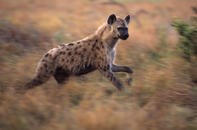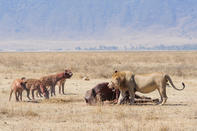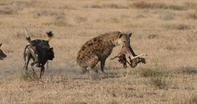Most Successful
The spotted hyena is arguably the most successful large carnivore in Africa because it is both a proficient hunter and scavenger exhibiting resourcefulness and stamina in its foraging pursuits.

It is the only mammal able to digest bone which it crushes easily in its powerful jaws and thereby extracts calcium and protein unavailable to other animals. Hyenas are extremely mobile and travel up to 70 km in a night to access food if need be.
Hyena vs Lion

Hyena are coursers, hunting by chasing prey until they or the prey exhaust. They form the vital ecological function of eliminating sick and old animals from populations, the easiest targets.
They choose a victim by blundering into the middle of a herd of animals and do not stalk in the manner of cats. Hyena are more successful as hunters than similarly sized predators due to their remarkable endurance. They are able to chase prey at a speed of 60 kmph for over two kilometres and have been known to follow herds of animals almost 30 km before making a kill.
They may hunt alone or in cooperative groups. Since hyena scavenge so readily, it is thought that they play a role in the natural control of diseases like anthrax by disposing of carcasses. The degree to which hyena scavenge depends on the concentration of lion in a given area.
Where lion are numerous, hyenas scavenge more often. Where hyena numbers are high and lion numbers low, hyena hunt more often, and lions then scavenge from them. Hyenas will dispossess lions of their food if they have the advantage of four hyena to one lioness.
Droppings and Pellets

By Megan Emmett